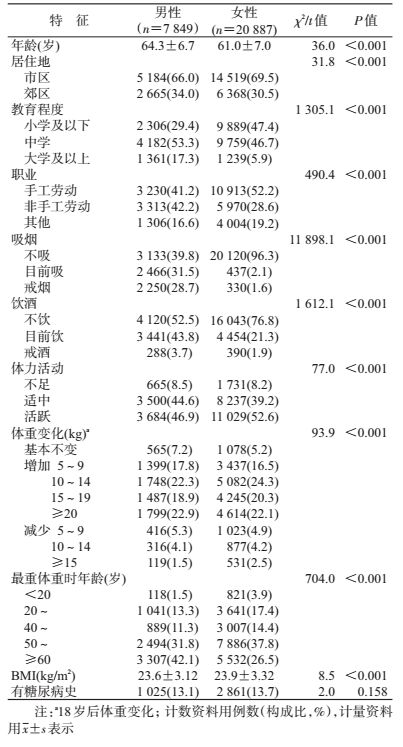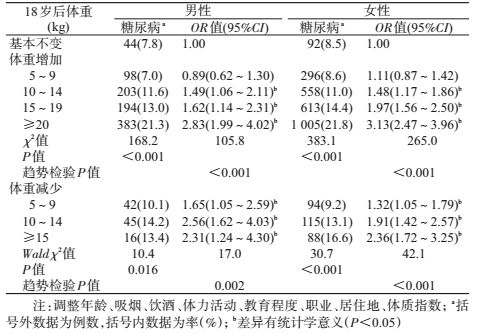文章信息
- 胡强, 江朝强, 张维森, 郑家强, 徐琳, 靳雅丽, 沈振敏, 朱峰, 林大庆.
- Hu Qiang, Jiang Chaoqiang, Zhang Weisen, Cheng Karkeung, Xu Lin, Jin Yali, Shen Zhenmin, Zhu Feng, Lam Taihing.
- 成年早中期体重变化与中老年糖尿病的相关性研究
- Association between body weight change during early and middle adulthood and the risk of type 2 diabetes in middle aged and elderly population
- 中华流行病学杂志, 2017, 38(12): 1699-1702
- Chinese journal of Epidemiology, 2017, 38(12): 1699-1702
- http://dx.doi.org/10.3760/cma.j.issn.0254-6450.2017.12.023
-
文章历史
收稿日期: 2017-05-04
2. 英国伯明翰大学公共卫生与流行病学系;
3. 510080 广州, 中山大学公共卫生学院;
4. 999077 中国香港大学公共卫生学院
2. Department of Public Health and Epidemiology, University of Birmingham, Birmingham B15 2TT, UK;
3. School of Public Health, Sun Yat-sen University, Guangzhou 510080, China;
4. Department of Community Medicine, School of Public Health, University of Hong Kong, Hong Kong 999077, China
肥胖与多种重大慢性疾病包括冠心病和肿瘤密切相关,已成为全球性的公共卫生问题[1]。研究表明,超重/肥胖为糖尿病的重要病因之一[2-4],成年早期的体重状态以及中年期的体重变化会增加患糖尿病、冠心病等慢性疾病的风险[5-7]。随着经济条件的改善和生活水平提高,超重/肥胖人群明显增加,而体形变化对中老年人糖尿病患病影响如何,是否为独立于中老年体形状态外的一组糖尿病影响因素,本研究利用“广州生物库队列研究”(GBCS)基线资料,开展此项研究。
对象与方法1.研究对象:GBCS是由广州市第十二人民医院、中国香港大学和英国伯明翰大学三方合作的研究项目,旨在研究基因、生活方式、环境因素等对各种慢性疾病的影响[8-9]。研究对象均来自广州市尊老康乐协会,该协会是广州市年长者民间组织,在各辖区均设有分会,会员约10万,均为广州市居民。GBCS选该协会中年龄≥50岁,能自行到广州市第十二人民医院,并自愿参加免费体检和接受健康问卷调查的广州市居民,2003-2008年分三期共招募研究对象30 518人,研究对象均签署知情同意书。本文选该队列基线调查资料进行现况研究,在排除了成年早、中期体重变化等主要研究指标不完整者,以及成年后体重基本不变组中体型偏瘦和超重/肥胖者后,共纳入研究对象28 736人。
2.研究方法:基线资料采用面对面的标准化电子问卷调查。问卷调查由6~8名有医学背景并受过专门培训合格的助理护士完成。10个辖区分会每天安排1个分会约40名会员接受调查和体检,10 d一次轮换,包括一般人口信息(年龄、性别、教育程度、职业、居住地等),生活方式(体力运动、吸烟、饮酒状况等),成年(≥18岁)体重变化,达到最重体重时的年龄,糖尿病史等,同时测量身高、体重,检测FPG及2 h口服葡萄糖耐量试验等。
3.相关指标定义:①吸烟指目前吸烟且≥1年或戒烟未满1年;不吸烟指目前不吸烟或吸烟未达1年;戒烟指以前吸烟,但现在不吸烟≥1年。②饮酒指过去1年内每月至少饮1次白酒、啤酒或其他酒精饮料;不饮酒指从未饮酒或过去1年饮酒但每月不足1次;戒酒指既往有饮酒但过去1年从未再饮。③体力活动划分采用WHO提供的国际体力活动问卷(IPAQ),根据其活动强度和代谢能量(MET)分为不足、中等和活跃3个等级。2型糖尿病(T2DM)定义为FPG≥7.0 mmol/L,或自报糖尿病(有糖尿病史或服用降糖药治疗史);新诊断糖尿病定义为体检时发现FPG≥7.0 mmol/L,且无自报糖尿病。④地区划分按广州市行政区域分为城区(东山区、荔湾区、越秀区、海珠区、天河区和芳村)和郊区(白云、黄埔、番禺、花都、增城、从化区)。⑤职业分为手工劳动者(农林牧渔、工矿、销售/服务行业人员)、非手工劳动者(行政/管理或专业/技术人员或军人/警察)及其他劳动者(家庭主妇/主男或无职业或其他人员)。
4.统计学分析:采用SPSS 19.0软件进行数据分析。计量资料用x±s表示,性别间比较采用独立样本的t检验;计数资料性别间构成比较采用χ2检验。采用logistic回归模型分析成年后体重变化,保持最重体重时的年龄等与糖尿病的关系,并计算OR值及其95%CI,以P<0.05为差异有统计学意义。
结果1.一般特征:28 736名研究对象中男性7 849人,女性20 887人,年龄分别为(64.3±6.7)岁和(61.0±7.0)岁;糖尿病患病率男女性基本一致(13.1%和13.7%);男性曾经吸烟和曾经饮酒者分别占60.2%和47.5%,均明显高于女性的3.7%和23.2%;男女性体力活动不足者仅分别占8.5%和8.2%。男女性18岁后均以体重增加为主,其中>60%自报50岁以后才保持最重体重;而本次纳入的研究对象在GBCS基线体检时平均BMI男性为(23.6±3.1)kg/m2,女性为(23.9±3.3)kg/m2(表 1)。
2.多因素logistic回归分析:
(1)成年后体重改变与中老年糖尿病患病的风险:在调整年龄、吸烟、饮酒、体力活动、教育程度、职业、居住地和BMI后,与成年后体重基本不变者相比,患糖尿病的风险随成年(18岁)后体重增加而增加(趋势检验P<0.01),以体重增加≥20 kg者患病风险最大,男女性患糖尿病的风险分别增加183%(95%CI:99%~302%)和213%(95%CI:147%~296%)。见表 2。
(2)成年后体重减少与新诊断糖尿病和自报糖尿病的相关性:为进一步探讨体重减少者对糖尿病患病风险的影响,将现患糖尿病分为自报现患糖尿病和新诊断糖尿病进行亚组分析,在调整了相关影响因素后,与18岁后体重基本不变者相比,成年后体重减少主要与自报糖尿病有关,对新诊断糖尿病影响的差异无统计学意义,自报糖尿病患病风险有随体重减少而增加的趋势(表 3)。
(3)达到最重体重时的年龄与糖尿病患病的风险:在调整了相关影响因素后,与<20岁时已达到最重体重组相比,达到最重体重发生在20岁之后各年龄组的糖尿病患病风险均有不同程度的增加,以40~岁组达到最重体重患糖尿病的风险最高,OR值男女性分别为5.32(95%CI:1.92~14.8)和3.41(95%CI:2.49~4.67)。见表 4。
本研究发现成年早中期体重变化以及出现明显增重的年龄与中老年糖尿病患病风险显著相关,糖尿病患病风险随成年早中期体重增加而增高,在40~49岁年龄段达到最重体重者患糖尿病的风险最高。
2010年中国慢性病国家疾病监测系统抽样调查显示,超重/肥胖者患糖尿病的风险分别为BMI正常者的1.8倍和2.9倍[10]。Oguma等[11]的研究显示,BMI每年增加>0.05 kg/m2者T2DM患病风险为体重基本无变化者的1.93倍。另一项来自日本的研究显示,随着20岁时BMI水平增高,40岁时罹患糖尿病的风险呈逐渐上升趋势(P<0.001)[12]。我国学者周龙等[5]的研究显示,25岁时超重/肥胖以及随后的体重增加均与中年时期新发糖尿病正相关。本研究显示,成年后体重增加患T2DM的风险加大,且有随体重增加而逐渐增加的趋势,与上述结论相近。另外,一些研究发现体重减轻能降低糖尿病的发病风险[13-15]。宁锋等[13]对青岛市35~74岁成年人研究显示,体重减少>5%可降低58%的糖尿病患病率。本文未发现相同或相近结果。相反,却发现体重减少与自报现患T2DM有关,与新诊断糖尿病无显著相关。
本研究还提示,达到最重体重时的年龄也是影响糖尿病患病的一个重要因素,与成年早期(<20岁)达到最重体重相比,40~49岁时达到最重体重者患糖尿病的风险最高。结合本研究入组研究对象的年龄提示,由增重、肥胖带来的糖尿病等慢性病风险有一定的时间差,综合上述研究可初步推测,由增重高峰(超重/肥胖)到糖尿病发生估计10~20年。
本研究存在局限性。首先,采用横断面基线调查数据,不能确定体重变化与糖尿病的因果关系,但研究对象成年早中期的体重变化与中老年期糖尿病患病,可一定程度上体现体重变化与糖尿病发生的关系。其次,成年早期的体重变化是通过调查问卷获得,可能存在回忆偏倚。此外,本研究男女性别比例失衡,可能影响结论外推。
综上所述,本研究表明成年早中期体重增加可增加中老年时期糖尿病患病风险,明显增重到发生糖尿病可能相隔10~20年。糖尿病防控关口应前移,预防早年肥胖是关键。
利益冲突: 无
| [1] | No authors listed. Obesity:preventing and managing the global epidemic. Report of a WHO consultation[J]. World Health Organ Tech Rep Ser, 2000, 894: 1–253. |
| [2] | Jung HS, Chang Y, Eun YK, et al. Impact of body mass index, metabolic health and weight change on incident diabetes in a Korean population[J]. Obesity, 2014, 22(8): 1880–1887. DOI:10.1002/oby.20751 |
| [3] | Wang C, Li JX, Xue HF, et al. Type 2 diabetes mellitus incidence in Chinese:contributions of overweight and obesity[J]. Diabetes Res Clin Pract, 2015, 103(3): 424–432. DOI:10.1016/j.diabres.2014.09.059 |
| [4] | Nguyen NT, Nguyen XM, Lane J, et al. Relationship between obesity and diabetes in a US adult population:Findings from the national health and nutrition examination survey, 1999-2006[J]. Obes Surg, 2011, 21(3): 351–355. DOI:10.1007/s11695-010-0335-4 |
| [5] |
周龙, 赵连成, 李莹, 等.
成年早期体重状态及至中年期体重变化与新发2型糖尿病的关系[J]. 中华流行病学杂志, 2016, 37(3): 339–343.
Zhou L, Zhao LC, Li Y, et al. Relationship between body weight status in early adulthood and body weight change at middle age in adults and type 2 diabetes mellitus[J]. Chin J Epidemiol, 2016, 37(3): 339–343. DOI:10.3760/cma.j.issn.0254-6450.2016.03.009 |
| [6] | Chei CL, Iso H, Yamagishi K, et al. Body mass index and weight change since 20 years of age and risk of coronary heart disease among Japanese:the Japan Public Health Center-Based Study[J]. Int J Obes, 2008, 32(1): 144–151. DOI:10.1038/sj.ijo.0803686 |
| [7] |
陈晓英, 吴照帆, 王学才, 等.
体质指数动态变化与2型糖尿病发病关系的前瞻性研究[J]. 中华流行病学杂志, 2016, 37(10): 1332–1335.
Chen XY, Wu ZF, Wang XC, et al. Association between body mass index and its change and type 2 diabetes mellitus risk in a prospective study[J]. Chin J Epidemiol, 2016, 37(10): 1332–1335. DOI:10.3760/cma.j.issn.0254-6450.2016.10.003 |
| [8] | Jiang CQ, Thomas GN, Lam TH, et al. Cohort profile:The Guangzhou Biobank Cohort Study, a Guangzhou-Hong Kong-Birmingham collaboration[J]. Int J Epidemiol, 2006, 35(4): 844–852. DOI:10.1093/ije/dyl131 |
| [9] |
江朝强, 林大庆, 郑家强, 等.
建立广州生物库进行慢性重大疾病研究概述[J]. 中国预防医学杂志, 2013, 14(11): 801–808.
Jiang CQ, Lin DQ, Zheng JQ, et al. Establishment of the Guangzhou Biobank for the study of major chronic diseases:the past and coming decades[J]. Chin Prev Med, 2013, 14(11): 801–808. DOI:10.16506/j.1009-66392013.11.006 |
| [10] |
李剑虹, 王丽敏, 黄正京, 等.
中国成年人体重指数与心血管危险因素关系的研究[J]. 中华流行病学杂志, 2014, 35(9): 977–980.
Li JH, Wang LM, Huang ZJ, et al. Study on the relationship between BMI and the risk of cardiovascular among Chinese adults[J]. Chin J Epidemiol, 2014, 35(9): 977–980. DOI:10.3760/cma.j.issn.0254-6450.2014.09.001 |
| [11] | Oguma Y, Sesso HD, Paffenbarger RJ, et al. Weight change and risk of developing type 2 diabetes[J]. Obes Res, 2005, 13(5): 945–951. DOI:10.1038/oby.2005.109 |
| [12] | Hatanaka Y, Tamakoshi A, Tsushita K. Impact of body mass index on men in their 20s and the effects of subsequent changes in body weight upon the rates of hypertension and diabetes and medical costs in their 40s[J]. Sangyo Eiseigaku Zasshi, 2012, 54(4): 141–149. DOI:10.1539/sangyoeisei.B11018 |
| [13] |
宁锋, 汪韶洁, 王玉美, 等.
青岛地区成年人体重变化和糖尿病发病率相关性研究[J]. 中华流行病学杂志, 2014, 35(7): 764–768.
Ning F, Wang SJ, Wang YM, et al. Weight change in association with the incidence of type 2 diabetes in adults from Qingdao China[J]. Chin J Epidemiol, 2014, 35(7): 764–768. DOI:10.3760/cma.j.issn.0254-6450.2014.07.002 |
| [14] | de Mutsert R, Sun Q, Willett WC, et al. Overweight in early adulthood, adult weight change, and risk of type 2 diabetes, cardiovascular diseases, and certain cancers in men:a cohort study[J]. Am J Epidemiol, 2014, 179(11): 1353–1365. DOI:10.1093/aje/kwu052 |
| [15] | Wannamethee SG. Overweight and obesity and weight change in middle aged men:impact on cardiovascular disease and diabetes[J]. J Epidemiol Community Health, 2005, 59(2): 134–139. DOI:10.1136/jech2003.015651 |
 2017, Vol. 38
2017, Vol. 38






